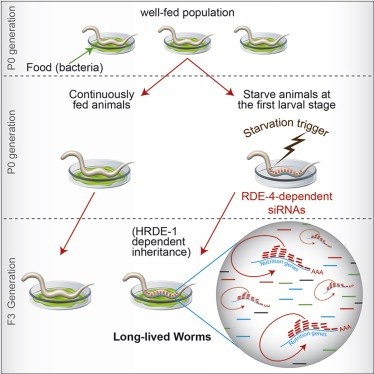
Evidence from human famines and animal studies suggests that starvation can affect the health of descendants of famished individuals. But how such an acquired trait might be transmitted from one generation to the next has not been clear. A new study, involving roundworms, shows that starvation induces specific changes in so-called small RNAs and that these changes are inherited through at least three consecutive generations, apparently without any DNA involvement. The study, conducted by Columbia University Medical Center (CUMC) researchers, offers intriguing new evidence that the biology of inheritance is more complicated than previously thought. The study was published in the July 10 online edition of the journal Cell.
The idea that acquired traits can be inherited dates back to Jean Baptiste Larmarck (1744-1829), who proposed that species evolve when individuals adapt to their environment and transmit the acquired traits to their offspring. According to Lamarckian inheritance, for example, giraffes developed elongated long necks as they stretched to feed on the leaves of high trees, an acquired advantage that was inherited by subsequent generations. In contrast, Charles Darwin (1809-82) later theorized that random mutations that offer an organism a competitive advantage drive a species' evolution. In the case of the giraffe, individuals that happened to have slightly longer necks had a better chance of securing food and thus were able to have more offspring. The subsequent discovery of hereditary genetics supported Darwin's theory, and Lamarck's ideas faded into obscurity.
"However, events like the Dutch famine of World War II have compelled scientists to take a fresh look at acquired inheritance," said study leader Oliver Hobert, PhD, professor of biochemistry and molecular biophysics and a Howard Hughes Medical Institute Investigator at CUMC. Starving women who gave birth during the famine had children who were unusually susceptible to obesity and other metabolic disorders, as were their grandchildren. Controlled animal experiments have found similar results, including a study in rats demonstrating that chronic high-fat diets in fathers result in obesity in their female offspring.
In a 2011 study, Oded Rechavi, a postdoctoral fellow in Dr. Hobert's laboratory, found that roundworms (C. elegans) that developed resistance to a virus were able to pass along that immunity to their progeny for many consecutive generations. The immunity was transferred in the form of small viral-silencing RNAs working independently of the organism's genome. Other studies have reported similar findings, but none of these addressed whether a biological response induced by natural circumstances, such as famine, could be passed on to subsequent generations.
To address this question, Dr. Hobert's team starved roundworms for six days and then examined their cells for molecular changes. The starved roundworms, but not controls, were found to have generated a specific set of small RNAs. (Small RNAs are involved in various aspects of gene expression but do not code for proteins.) The small RNAs persisted for at least three generations, even though the worms were fed normal diets. The researchers also found that these small RNAs target genes with roles in nutrition.
Since these small RNAs are produced only in response to starvation, they had to have been passed from one generation to another. "We know from other studies that small RNAs can be transported from cell to cell around the body," said Dr. Hobert. "So, it's conceivable that the starvation-induced small RNAs found their way into the worms' germ cells -- that is, their sperm or eggs. When the worms reproduced, the small RNAs could have been transmitted generationally in the cell body of the germ cells, independent of the DNA."
The study also found that the progeny of the starved worms had a longer life span than the progeny of the controls. "We have not shown that the starvation-induced small RNAs were responsible for the increased longevity -- it's just a correlation," said Dr. Hobert. "But it's possible that these small RNAs provided a means for the worms to control the expression of relevant genes in later generations."
The findings have no immediate clinical application. "However, they do suggest that we should be aware of other things -- beyond pure DNA changes -- that may have a long-term impact on the health of an organism," said Dr. Hobert. "In other words, something that happened to one generation, whether famine or some other traumatic event, may be relevant to the health of its descendants for generations."
Story Source:
The above story is based on materials provided by Columbia University Medical Center. Note: Materials may be edited for content and length.
Journal Reference:
Oded Rechavi, Leah Houri-Ze’evi, Sarit Anava, Wee Siong Sho Goh, Sze Yen Kerk, Gregory J. Hannon, Oliver Hobert. Starvation-Induced Transgenerational Inheritance of Small RNAs in C. elegans. Cell, 2014; DOI:10.1016/j.cell.2014.06.020
